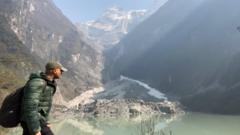In Kathmandu, a once vibrant view of the Himalayas has become a rarity, overshadowed by persistent haze that often obscures the skyline. Local hoteliers like Yogendra Shakya have had to adjust their business models, shifting from mountain views to cultural experiences as air quality deteriorates. The unusual weather patterns suggest that the spring and autumn months, typically associated with clear skies, are now indistinguishable from the haze of summer. Trekking guide Lucky Chhetri warns of a worrying trend in the industry, with many operators suffering a steep decline in business due to the inability to showcase the famous mountain range.
The effects extend across the border into India, where tour operators observe a noticeable increase in haze density with little respite. Locals in Pakistan note that areas once famous for their clear views of the Himalayas are now often enveloped in pollution. Common sources of air pollution in the region include vehicular emissions, industrial discharges, and seasonal agricultural burning.
Experts indicate that the Himalayas are among the mountains most affected by these ongoing conditions, as they lie within a densely populated and polluted area. During a recent analysis, data showed a dramatic rise in hazy days, with major tourist hubs experiencing more than 160 such days recorded in 2024 alone. This troubling trajectory raises concerns that the vibrant vistas of the Himalayas may soon reside only in photographs, leaving both guides and tourists yearning for the breathtaking experiences that are increasingly out of reach.
Despite the challenges, some travelers remain persistent, trying repeatedly to catch fleeting glimpses of the peaks, while the local tourism industry grapples with a future overshadowed by haze and uncertainty. As climate change continues to exacerbate air pollution, the allure of the Himalayas hangs in the balance, urging urgent action to safeguard this iconic region.
The effects extend across the border into India, where tour operators observe a noticeable increase in haze density with little respite. Locals in Pakistan note that areas once famous for their clear views of the Himalayas are now often enveloped in pollution. Common sources of air pollution in the region include vehicular emissions, industrial discharges, and seasonal agricultural burning.
Experts indicate that the Himalayas are among the mountains most affected by these ongoing conditions, as they lie within a densely populated and polluted area. During a recent analysis, data showed a dramatic rise in hazy days, with major tourist hubs experiencing more than 160 such days recorded in 2024 alone. This troubling trajectory raises concerns that the vibrant vistas of the Himalayas may soon reside only in photographs, leaving both guides and tourists yearning for the breathtaking experiences that are increasingly out of reach.
Despite the challenges, some travelers remain persistent, trying repeatedly to catch fleeting glimpses of the peaks, while the local tourism industry grapples with a future overshadowed by haze and uncertainty. As climate change continues to exacerbate air pollution, the allure of the Himalayas hangs in the balance, urging urgent action to safeguard this iconic region.
















